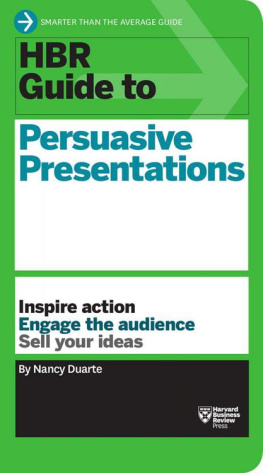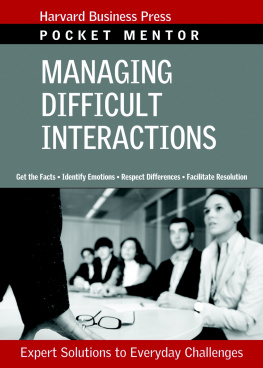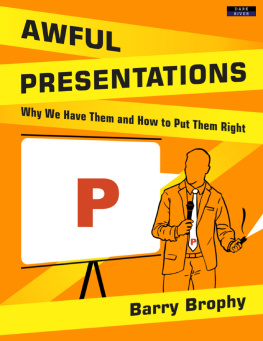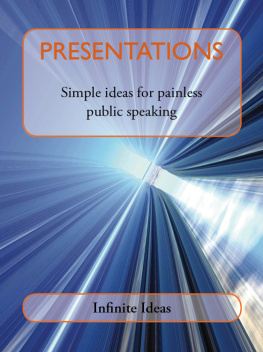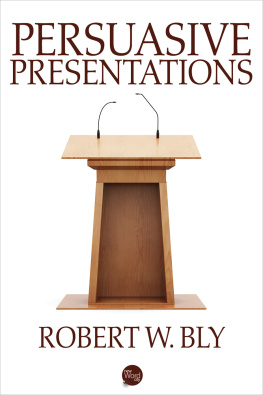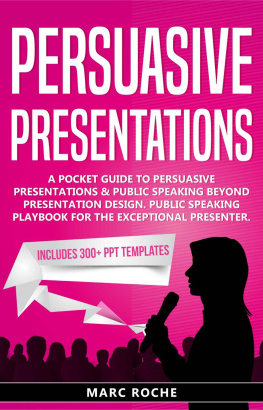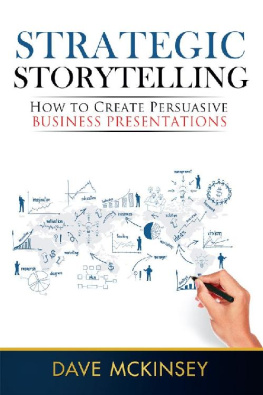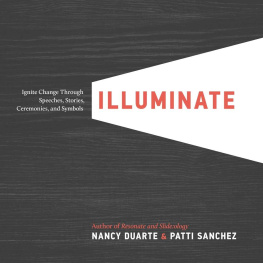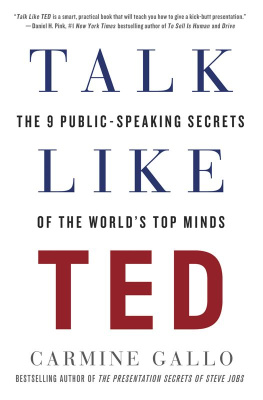HBR Guide to
Persuasive
Presentations
Harvard Business Review Guides
Arm yourself with the advice you need to succeed on the job, from the most trusted brand in business. Packed with how-to essentials from leading experts, the HBR Guides provide smart answers to your most pressing work challenges.
The titles include:
HBR Guide to Better Business Writing HBR Guide to Finance Basics for Managers HBR Guide to Getting a Job HBR Guide to Getting the Mentoring You Need HBR Guide to Getting the Right Work Done HBR Guide to Giving Effective Feedback HBR Guide to Making Every Meeting Matter HBR Guide to Managing Stress HBR Guide to Managing Up and Across HBR Guide to Persuasive Presentations HBR Guide to Project Management
HBR Guide to
Persuasive
Presentations
Nancy Duarte
HARVARD BUSINESS REVIEW PRESS
Boston, Massachusetts
Copyright 2012 Harvard Business School Publishing Corporation
All rights reserved
Printed in the United States of America
No part of this publication may be reproduced, stored in or introduced into a retrieval system, or transmitted, in any form, or by any means (electronic, mechanical, photocopying, recording, or otherwise), without the prior permission of the publisher. Requests for permission should be directed to , or mailed to Permissions, Harvard Business School Publishing, 60 Harvard Way, Boston, Massachusetts 02163.
Library of Congress Cataloging-in-Publication Data (Print)
Duarte, Nancy.
HBR guide to persuasive presentations / Nancy Duarte. p. cm. ISBN 978-1-4221-8710-4 (alk. paper) 1. Business presentations. 2. Persuasion (Psychology) I. Title. HF5718.22.D817 2012 658.452dc23 2012019634
eBook development by eBook Architects

QED stands for Quality, Excellence and Design. The QED seal of approval shown here verifies that this eBook has passed a rigorous quality assurance process and will render well in most eBook reading platforms.
For more information please click here.
What Youll Learn
Do you dread giving presentations? Maybe your mind goes blank when you sit down to generate ideas, or you struggle to organize your fragmented thoughts and data into a coherent, persuasive message. Is it tough to connect with customers youre wooing, senior executives youre hitting up for funding, or employees youre training? Do you fumble for the right words, get lost in your slide deck, run out of time before youve hit your main pointsand leave the room uncertain youve gotten through to anyone ?
This guide will give you the confidence and tools you need to engage your audience, sell your ideas, and inspire people to act. Youll get better at:
- Showing people why your ideas matter to them
- Winning over tough crowds
- Balancing analytical and emotional appeal
- Crafting memorable messages
- Creating powerful visuals
- Striking the right tone
- Holding your audiences attention
- Measuring your impact
Contents
Plan well.
Know your audience and build empathy.
Your ideas fate is in their hands.
Focus on who matters most.
Help them make big decisions on a tight schedule.
Its easier to convince someone you know.
What do you want people to believe? How do you want them to behave?
Resonate through empathy.
Develop persuasive content.
Clearly state your point of viewand whats at stake.
When youre brainstorming, more is more.
Think through opposing perspectives.
Create and resolve tension.
Get things done!
Sort and filter.
Outline your presentation by writing clear, active slide titles that hang together.
Stay credible while you reel people in.
Is your language clear enough to pass the grandmother test?
Good ones get repeated, tweeted, and heeded.
Use storytelling principles and structure to engage your audience.
Make your presentation stick.
Storytelling principles provide a framework.
Establish the gap between what is and what could be.
Build tension between what is and what could be.
Describe the new bliss.
Decisions are not made by facts alone.
Memorable themes help rally an audience.
Drive your big idea home.
Identify the best modes for communicating your message.
Slide decks arent always the answer.
Its not just for slides.
Keep your audience engaged by budgeting your time.
Communicate before, during, and after your presentation.
Mixing in experts and media holds interest.
Conceptualize and simplify the display of information.
Visuals should convey meaning.
Do they pass the glance test?
Bullets arent the only tool.
Plan before you create.
Make your slides stand out.
Make your visuals easier to process.
Emphasize whats important, remove the rest.
Use shapes to show relationships.
Size up your situation before building your deck.
... and when its overkill.
Deliver your presentation authentically.
Roll with the unexpected and fully engage with the audience.
Control them when you can.
Odds of malfunction are high.
Exercises to calm your nerves.
You never get a second chance to make a first impression.
Authenticity connects you to others.
Physical expression is a powerful tool.
Create contrast and emphasis.
Re-experience them in the telling.
Pay attention to chemistry, pacing, and cultural resonance.
Plan, plan, plan.
Get past technologys barriers.
Youre fighting for the attention of multitaskers.
Use this checklist to minimize annoyances.
Measureand increaseyour presentations impact on your audience.
Engage with users so theyll engage fully and fairly with your ideas.
Facilitate the online conversation.
Gather feedback in real time and after your talk.
Make it easier for people to put your ideas into action.
Introduction
If I am to speak for ten minutes, I need a week for preparation; if fifteen minutes, three days; if half an hour, two days; if an hour, I am ready now.
Woodrow T. Wilson
We work in a first-draft culture. Type an e-mail. Send. Write a blog entry. Post. Whip up some slides. Speak.
But its in crafting and recraftingin iteration and rehearsalthat excellence emerges.
Why worry about being an excellent communicator when you have so many other pressing things to do? Because it will help you get those things done.
So as you conceive, visualize, and present your message, dont skimp on preparation, even if youre giving a short talk. It actually takes more careful planning to distill your ideas into a few key takeaways than it does to create an hour-long presentation (see ). And gather lots of feedback so youll be all the more effective when you start the process again.
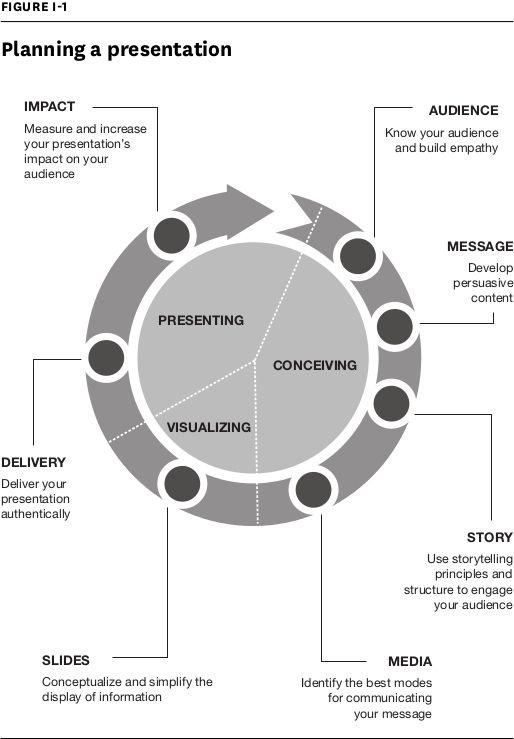
Since 1990, Ive run a firm that specializes in writing and producing presentationsand then I became a presenter myself. This book is loaded with insights learned from supporting other presenters and giving my own talks. But, trust me, Ive had my share of embarrassing moments, many of which could have been avoided with a little planning. Loading the wrong presentation onto my laptop. Walking onstage with my skirt tucked into my underwear. Botching my delivery to executives at an $8 billion company because I hadnt rehearsed enoughand getting cut from their continuing series of meetings. Experience is a powerful teacher.

